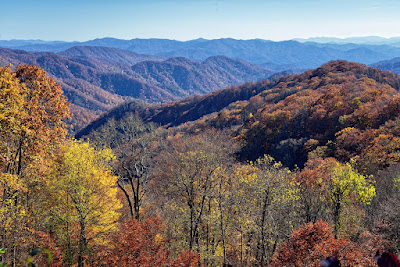 |
| There's nothing like the Smoky Mountains in Fall. |
This past week here in the U.S. we celebrated Indigenous Peoples’ Day, a holiday updating the long inaccurate and inappropriate “Columbus Day” meant to honor the “discoverer of America.” The problem with that was that Christopher Columbus didn’t really discover America (indigenous people had been living here for centuries and, besides, Leif Erickson had sailed from Europe before, too) and what followed Columbus’s landing wasn’t exactly something to celebrate for the folks living here, either.
So, Indigenous Peoples’ Day has a better ring to it. Here in Western North Carolina, the indigenous Cherokee exert a subtle presence over the land those of us of European descent have overtaken. Somehow that’s inevitable, not only because so many of the features of the landscape—mountains, rivers, towns—have Cherokee names, but also because the Cherokee lived in such close association with the environment that their spirit can still be felt here if you take the time to listen for it.
I spent the day after Indigenous Peoples’ Day in modern-day Cherokee country, across the old Quallah Boundary, west of my home in Marshall, in Great Smoky Mountains National Park and the town of Cherokee next door. Signs were written in both English and Cherokee (one of the first written Native languages), billboards advertised local Native crafts and businesses and, of course, Unto These Hills, the play written about the Trail of Tears.
Even folks who aren’t from this area are familiar with the story of the Indian Removal Act of 1830, passed by slim vote in Congress under the presidency of Andrew Jackson. Not only the Cherokee, but members of all Five Civilized Tribes (Cherokee, Chicasaw, Creek, Choctaw, and Seminole) from Michigan to Louisiana and Florida were subject to removal across the Mississippi under the act, to “Indian territory” (Oklahoma).
Seminole leaders fled into the swamps of Florida and largely avoided removal. Cherokees under the leadership of Junaluska (who had once saved Jackson life in battle) and others resisted by legal means since many were educated and owned farms and businesses. But they were betrayed by three others, who signed over their land for a promised sum of $5 million in the 1835 Treaty of New Echota. Despite the fact that the Cherokee Nation as a whole rejected the treaty, some 16,000 Cherokee were forcibly removed from their homes two years after Congress ratified the treaty in 1836. Four thousand died on the way to Oklahoma, a trip made mostly in winter, with little food. They were buried in unmarked graves, far from home.
A small band of Cherokee families owned land around the Oconoluftee River in Western North Carolina under earlier treaties and, after a special appeal to the North Carolina legislature, was allowed to stay behind. Another group of 300-400 led by a man named Tsali hid in the mountains and avoided capture during the removal. Tsali was eventually captured by Federal soldiers but negotiated to allow his people to stay. All in all, about a thousand Cherokee remained in Western North Carolina (or returned from Oklahoma) to serve as the ancestors of what is today the Eastern Band of Cherokee Indians, who live centered in around Cherokee, NC.
On an earlier trip to Cherokee, I visited the excellent Museum of the Cherokee Indian, which is part history, part art museum. When I was much younger (like 12), I visited the living history Oconoluftee Indian Village, a recreation of a Cherokee village of the 18th Century. I guess you could say I’ve always been fascinated with Native culture.
I didn’t set out to visit Cherokee for Indigenous Peoples’ Day. That was just a happy coincidence. Hubby and I spent the weekend in Pigeon Forge, Tennessee, home of Dolly Parton’s Dollywood theme park—our first getaway that wasn’t related to family since COVID. Turned out it was a perfect fall weekend, with the leaves turning, the sun shining, the breeze just crisp enough. The crowds at Dollywood were a little overwhelming after all this time in isolation, but I love people-watching, so I got my fill of that. We ignored the rides and concentrated on the music (which was top-notch), the crafts and the food. Then we came back through the mountains, which were stunning.
The trip left us more grateful than ever to live in this wonderful place, once and still the home of the Cherokee.
Cheers, Donna

No comments:
Post a Comment
Thank you for chiming in! We love to see your comments. (All comments are moderated so spam can be terminated!)